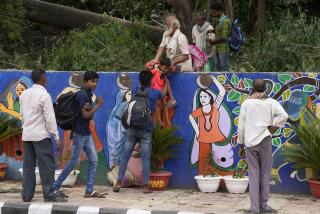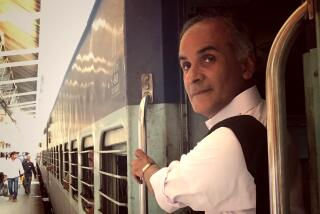Documentary : ‘Where Is This First World, Anyway?’ : London certainly seems as if it should be safe, clean and civilized. But after living in New Delhi’s Third World, a reporter finds that some things aren’t so different after all.
- Share via
LONDON — The assignment had all the makings of a summer vacation.
After eight years of living with riots, revolution, war and deprivation in the lower third of Asia’s Third World, I was put on a plane from New Delhi to London on temporary assignment--in my editors’ words, “to taste the First World and all it has to offer.”
But within the first few days of my landing in this urban citadel of the First World the following happened:
* A terrorist bomb ripped through a private supper club of Prime Minister Margaret Thatcher’s Conservative Party located just a few blocks from my hotel.
* Rampaging mobs of English soccer fans rioted across the country.
* Another bomb blew up in a trash bin half a block from the central London hotel where President Bush and other First World leaders were having breakfast.
* And London’s legendary underground and surface transport systems were repeatedly snarled by bomb scares, breakdowns and anonymous “technical faults.”
“I must’ve taken a wrong turn at Bangladesh,” I commented to a colleague in the midst of it all. We were standing among drug dealers and car thieves in a dilapidated London housing project where, a few days before, three police officers had been attacked and beaten during a drug bust.
“I mean, where is this First World, anyway?”
My colleague smiled knowingly. “This is it, my friend,” he said, nodding. “You can run, but you can’t hide.”
True enough.
In an era when the boundaries between nations are crumbling under the weight of a new, pragmatic world order, the distinctions between the so-called First and Third Worlds seem to be disintegrating faster than the ozone layer.
Terrorism is now a household word from Bombay to Bahrain and Belfast to Boston. And there is hardly a country left on Earth that can claim to be drug-free.
They’re smoking crack now from Calcutta to Kuwait, battling AIDS from Manila to Malta and mopping up oil spills from Alaska to Aberdeen. Similarly, Asian gang warfare has been transplanted to the streets of Los Angeles, Sydney and Liverpool.
South American drug cartels are exporting executions and street violence along with their multibillion-dollar trade.
But in all the world, there are perhaps few better laboratories in which to study this phenomenon of global shrinking--the gradual merging of the planet’s First and Third Worlds--than in London, my new summer home, and in New Delhi, which has been my home for five of the last eight years.
At first glance, the two cities seem worlds apart.
Brutality is a way of life in New Delhi, the capital of an impoverished nation of 850 million people, where beggars bang the stumps of amputated arms against the windows of cars at intersections, where nearly a third of the population lives in squatters’ shanties, where grooms’ families burn brides to death over insufficient dowries and where human waste commingles with uncollected garbage on many city streets.
London, by contrast, has Big Ben, Westminster Abbey and the West End, where alfresco diners sip fine French Champagne, down pints of the world’s best ale and savor continental cuisine along centuries-old cobblestone lanes.
But scratch the surface, and the similarities are there.
Take food, for example.
In Delhi, vast families of flies blanket what passes for beef at the local butcher shop. (It’s water buffalo, really, as cows remain largely sacred to the Hindus).
Then, on to the vegetable stand, where the bugs are far smaller. Amoebas, mostly. You can’t see them, but they’re there. If you eat a salad that has not spent its day in a solution of iodine and potassium, the bugs suddenly appear--in a form of dysentery curable only by medicine made from the same chemical used in industrial rat poison.
Then there’s the water. Don’t ask. Just don’t drink it.
By contrast, on my first day in London, a friend suggested that I drop by the Food Hall in Harrods department store to see all of the First World treasures that I had been missing all these years.
Now, as a mecca of capitalism, hedonism, epicureanism and sheer, obsessive decadance, Harrods stands alone. It’s six stories of unabashed opulence and elegance on 4 1/2 of the most expensive acres of London real estate.
It’s owned by an Egyptian entrepreneur who has the kind of public relations department that sends out releases boasting, “All things, for all people everywhere.”
It was in the midst of all of this, in the heart and center of Harrods’ endless ground floor, that I finally found the epic Food Hall. And indeed, it seemed light-years away from the diseased markets of Delhi.
The specialty salad counter alone offered 34 varieties, and, beyond it, the mammoth grocery hall opened up before me like an edible universe. There were French peaches, Brazilian figs, Peruvian pomegranates, South African pomelos, American cherries, New Zealand kiwis, Costa Rican bananas, English strawberries and pineapples from Mauritius. And none of it had bugs, a rosy-cheeked Irish saleswoman assured me, through a look of some suspicion.
But I saved the best for last.
The Meat Hall.
On one end of the cavernous room where vegetarians fear to tread, six giant sides of Scottish beef dangled from the ceiling like bait for the world’s largest carnivore. The assortment under a clean glass counter was dazzling: minced beef, shoulder beef, brisket beef, rump steak, entrecote steak, Scotch filet steak . . .
Then, suddenly, I realized that no one was actually buying any of it. In fact, in the midst of Harrods’ famous summer sale, a time when the store is so jammed with humanity that the public relations department says each of its 50 elevators may travel 100 miles in a single day, there wasn’t a single customer anywhere near the meat counter.
“I reckon it’s the Mad Cow Disease and all, gov,” the lonely butcher behind the counter said when I asked him why no one was buying his meat.
“The what?”
“Mad Cow, gov,” he repeated. “Some kinda brain disease they say is killin’ off our cows. ‘Course our meat’s fine enough, gov. Only the best here at Harrods. But, since the papers been fulla the Mad Cow scare, no one’s buyin’ beef no more.”
Sure enough, the newspapers reported the following day that Bovine Spongiform Encephalopathy, better known as Mad Cow Disease, had, indeed, killed tens of thousands of cows already.
You can run, but you can’t hide.
“Don’t drink the water,” another English friend warned me the day after my Food Hall visit.
“What water?” I asked, bewildered.
“Our water. London tap water. Ever since the waterworks went private, it’s full of diseases--you know, cholera, typhoid and the lot.”
“I know cholera and typhoid. That’s what we get when we drink the water in India,” I replied. “But this is the First World. Surely, you don’t have those diseases here anymore.”
“Hell, call ‘em what you want. But don’t drink the water.”
And sure enough, the following day I checked with the Royal Society, which confirmed that a large-scale investigation into the city’s water quality was under way after the discovery of cryptosporidium, a lethal, water-borne bacterium, in the drinking water of several areas in or near London.
Indeed, you can run, but you can’t hide.
Many Londoners, when asked about the “Third Worldization” of a metropolis so genteel and urbane it has long been considered the capital of the First World, blame Prime Minister Margaret Thatcher.
Others blame Britain’s moribund bureaucracy and work ethic, or lack thereof--problems that similarly plague the Indian nation that Britain helped build and govern during a century and a half of colonial rule. Still others blame England’s immigration policies, which brought hundreds of thousands of new residents from its former, Third World colonies to this island nation.
And yet, it was that same immigrant population that, more often than not, came to my rescue as I frantically tried to navigate through the surface culture shock and apparent time warp that lies between New Delhi and old London.
It was, in fact, through that acclimatization process that I stumbled onto the most striking illustration of global shrinking.
I was 200 feet beneath the city, and I was lost. It was my first attempt to negotiate the London Underground, the vast, snaking network of subway trains universally known as “the tube,” which, when it’s actually working, is the most pleasant and efficient urban mass transit system anywhere in the world.
On that particular day, though, it wasn’t. Victoria Station was closed after a train ran someone over, and St. James Park Station was closed after a bomb scare. I attempted to circumnavigate the underground nightmare by taking an alternate train and ended up in a place I couldn’t even pronounce.
I went to the ticket booth, asked directions and, without hesitation, the helpful clerk pulled out maps, drew lines, circled stations and generally set me back on course.
Grateful, I tried to strike up a conversation.
“Where are you from?” I asked.
“From London, of course,” he answered with a perfect British accent.
“But I was born in India.”
More to Read
Sign up for Essential California
The most important California stories and recommendations in your inbox every morning.
You may occasionally receive promotional content from the Los Angeles Times.










